Sitemap
A list of all the posts and pages found on the site. For you robots out there, there is an XML version available for digesting as well.
Pages
Blogs
activities
Debate Team of School of Mathematics and Statistics
Oct 2021 ~ Dec 2022
Fourth Debater, Henan University, China
I served as the fourth debater in the debate team of School of Mathematics and Statistics. As the closing speaker, I was responsible for delivering final rebuttals, synthesizing arguments, and constructing impactful conclusions. In addition to competing, I took on a mentoring role, helping train recruits by organizing internal workshops and preparing research materials for incoming debaters.
Stellar Corps, Young Sprout Association
Jan 2023 ~ Dec 2024
Teaching Volunteer, Shanghai Lingqing Philanthropy Development Center and Yuqing Middle School, China
I joined Young Sprout Association of Henan University and served as vice captain of Stellar Corps (chapter for high school students). Our team brought together members from diverse discipline backgrounds, including medicine, chemistry, physics, education, business and statistics. We collaborated with Lingqing Philanthropy Development Center in Shanghai and co-launched a long-term volunteer project with Yuqing Middle School in Baini Town, Yuqing County, Guizhou Province. We spent most vacations (winter, summer and national vacations) on volunteer teaching activities, student mentoring, and course design. Our team created a series of engaging extracurricular programs that integrated academic concepts with real-world challenges, such as:
- “Puzzle Tracker” – an interactive program introducing computer vision and image processing through puzzle-based games.
- “Hidden Gems in the Mountains” – a cultural exploration program combining local Miaoethnic herbal medicine rooted in Chinese cultural heritage.
Hope these efforts can inspire students to decode STEM principles through gamified challenges; discover cultural wisdom within real-world contexts; develop critical thinking via cross-disciplinary exploration. Moverover, this is not merely a top-down transmission of knowledge, but a two-way learning bridge that fosters mutual growth between them and teaching volunteers across generations. The project has been sustained for over two years, and I truly hope it will continue to grow and benefit more people in the years to come.
patents
Multi-modal Data Integration Based on Convolutional Sparse Coding and Optimal Transport
Xiaohui Yang, Jingjing Li, Yuan Feng, Lichao Peng, Yu Song, Meng’en Qin
Henan University and Yellow River Conservancy Technical Institute, CN117763499B, 2024
This invention proposes a multi-modal data integration method based on convolutional sparse coding and optimal transport. We utilize convolutional sparse coding to collaboratively learn the latent representations of two multi-modal features, thereby addressing the interpretability issues commonly associated with neural networks. To better capture the data distribution when generating the latent space, optimal transport theory is employed to mitigate the issue of non-overlapping between the real and generated distributions. Furthermore, alignment is performed based on the correlation matrix between the multi-modal data, and the aligned point pairs are used to fuse the latent spaces of the two modalities, ultimately achieving effective multi-modal data integration. This invention significantly improves the classification accuracy in the integrated latent space and is appropriate for multi-omics integration tasks in the biomedical field, such as single-cell sequencing data and medical imaging data analysis.
Intelligent Analysis Method of Stomatal Phenotype of Crop Non-destructive Leaves Based on HDIoU
Lichao Peng, Meng’en Qin, Xiaohui Yang, Chen Miao, Yanfeng Sun
Henan University, CN118691972A, 2024
In this invention, we design a triphasic Hellinger Distance based Intersection over Union (HDIoU) for oriented bounding boxes, and apply it to train YOLOv8-OBB on non-destructive leaf stomatal images. HDIoU models each oriented bounding box as a 2D normal distribution and computes the triphasic Hellinger distance between predicted and ground-truth distributions as the box regression loss. It enables models to focus on different objectives at different training periods: in the first phase, the goal is to quickly move the predicted box close to the target; in the second phase, the emphasis shifts to maximizing the overlap between the predicted and ground-truth boxes; in the third phase, the model additionally fine-tunes the predicted box dimensions to closely match the target box’s length and width. The triphasic mechanism does not require manually splitting the training, but leverages a dynamic indicator to automatically determine the current optimization focus during training, allowing the loss function to continuously transition within a single unified learning process. This design enables the model to progressively refine predicted boxes by adjusting its attention—from general proximity to precise alignment of orientation and shape—without interrupting training. Moreover, HDIoU is scale-invariant, making it particularly well-suited for accurately detecting small objects such as stomata.
Coal and Gangue Intelligent Recognition Based on Selective State Space Equation
Xiaohui Yang, Meng’en Qin, Yanni Zhang, Zheng Ge, Yunfei Bai
Henan University, CN119048740A, 2025
In the invention, we present an intelligent gangue recognition method based on the selective state space modeling, implemented within a lightweight deep learning network. Specifically, the proposed method is composed of a selective state space backbone, SimSPPF module, a multi-scale feature fusion layer, and a decoupled detection head. The state space backbone and SimSPPF module are jointly designed to extract both spatial and semantic information more effectively, thereby enhancing detection precision and robustness. The overall framework enables real-time gangue detection and localization across both still images and video streams, providing comprehensive information such as positions and sizes of coals and gangues. This invention offers strong support for the efficient utilization of coal resources, and is particularly suited for deployment in low-resource or mobile computing environments.
posts
projects
Intelligent Modeling of Organic Chemical Synthesis Based on Topological Data Analysis and Machine Learning
Nov 2023 ~ Mar 2024
Henan Engineering Research Center for Artificial Intelligence Theory and Algorithms, Henan, China
This project is the beginning of my research journey. I was fortunate to collaborate with Yanhui Guo and Prof. Xiaohui Yang in modeling organic chemical synthesis reactions using statistical and machine learning tools. In the two papers I contributed to, we utilized topological data analysis, ensemble learning (tree-based models), convolutional neural networks and multi-scale attention to build an intelligent system for yield analysis and prediction of organic synthesis. Our work aims to support researchers with comprehensive, multi-perspective decision-making information.
Investigation of Key Regulatory Factors and Molecular Mechanisms of Peanut Stomatal Phenotypes
Apr 2024 ~ Nov 2024
AITA and State Key Laboratory of Crop Stress Adaptation and Improvement, Henan, China
This project aims to collect and quantify stomatal phenotypes from live field-grown peanut plants using an intelligent recognition system. By integrating phenotypic, genotypic and environmental data, we can perform Genome-Wide Association Study (GWAS) and Genotype-by-Environment Interaction Analysis (G×E) to identify key and high-stable regulatory genes. The ultimate goal is to discover superior genetic resources for peanut breeding under variable environments and enhance its productivity and adaptability. In this project, I worked with Quanling Zhao and Prof. Xiaohui Yang from AITA, as well as Dr. Chenyang Du and Prof. Chen Miao from State Key Laboratory of Crop Stress Adaptation and Improvement, to finish the following works:
- Development of RGxEStat. RGxEStat is a user-friendly R GUI package designed for statistical analysis of genotype-by-environment interactions. It integrates: (1) significance analysis based on the mixed effect model to determine whether genes or GxE interactions significantly affect phenotypic traits; (2) single-gene and multi-gene stability analysis based on singular value effect decomposition, which further studies the interactive relationships between genes and environments, as well as the relative superiority or inferiority of genotypes across environments. This tool empowers breeders to identify environment-specific alleles associated with stomatal function, providing actionable insights for climate-resilient peanut breeding.
- StomaD², an end-to-end stomatal phenotyping system based on diffusion-based restoration detection network. StomaD² supports real-time imaging and quantification of stomatal phenotypes (e.g., density, conductance) in field conditions. It is also compatible with both monocot and dicot crops, and accepts both destructive and non-destructive microscopy images. Experimental results demonstrate that StomaD² achieves expert-level accuracy and high generalization across species, highlighting its potential for large-scale phenotyping, plant physiology research and precision agriculture.
- We propose a triphasic Hellinger Distance-based Intersection over Union (HDIoU) for oriented bounding box (OBB) regression, and integrate it into the training of YOLOv8-OBB on non-destructive leaf epidermal stomatal images. HDIoU utilizes a dynamic indicator to determine the current optimization focus during training, allowing the loss function to continuously transition across three objective phases within a single unified learning process. This triphasic design facilitates more accurate and efficient localization of target contours, yielding precise phenotypic information for stomatal studies. Furthermore, HDIoU is inherently scale-invariant, making it particularly effective for detecting small objects such as stomata in high-resolution biological imagery.
Development and Deployment of Audit Large Language Model
Dec 2024 ~ Apr 2025
AITA and Henan Provincial Audit Department, Henan, China
The primary objective of this project is to design, fine-tune and deploy a secure, internally-facing Audit Large Language Model (ALLM) to empower auditors at Henan Provincial Audit Department. Built atop Qwen foundation model, our ALLM need deliver intelligent support for audit Q&A, regulatory compliance and table-data analysis, improving audit efficiency and accuracy. In this project, I worked with Lutong Zhang and Haonan Zhang to finish the following tasks:
- Data Collection: Aggregating amounts of audit documentation, historical audit reports, government financial regulations (national and provincial level), accounting standards (e.g., Chinese GAAP), policy directives, compliance manuals, and best practice guidelines.
- Data Processing: Implementing data processing pipelines for heterogeneous audit sources, including: text extraction that applies PaddleOCR with regex-based digit correction for scanned documents, pdfplumber for layout-aware PDF, python-docx for DOCX files; spaCy + FinBERT for entity normalization of regulations/financial terms; DeepSeek-V2 classification for document categorization and UIE model for sensitivity tagging; LayoutLMv3 for context-aware semantic segmentation to preserve audit logic.
- Knowledge Vectorization: Utilizing BGE-M3 to transform textual knowledge into high-dimensional vectors indexed into Milvus with metadata filters, enabling efficient semantic search and retrieval.
- Synthetic QA Generation: Using Qwen-72B-Chat to produce question-answer pairs reflecting common audit scenarios, enriching our fine-tuning dataset.
- Expert Annotation: Collaborating with senior auditors to annotate real audit cases, identifying key entities, risks, compliance issues, and generating relevant queries/responses.
- Instruction Tuning: Formulating diverse instructions covering typical audit tasks (e.g., "Identify potential fraud indicators in this transaction log," "Explain the relevant regulation for expense X," "Summarize the key findings from report Y").
publications
OCS-TGBM: Intelligent Analysis of Organic Chemical Synthesis Based on Topological Data Analysis and LightGBM
Yanhui Guo*, Lichao Peng*, Zixin Li, Meng'en Qin, Xue Jiao, Yun Chai, and Xiaohui Yang† (* equal contribution, † corresponding author).
In MATCH-COMMUNICATIONS IN MATHEMATICAL AND IN COMPUTER CHEMISTRY, 2024
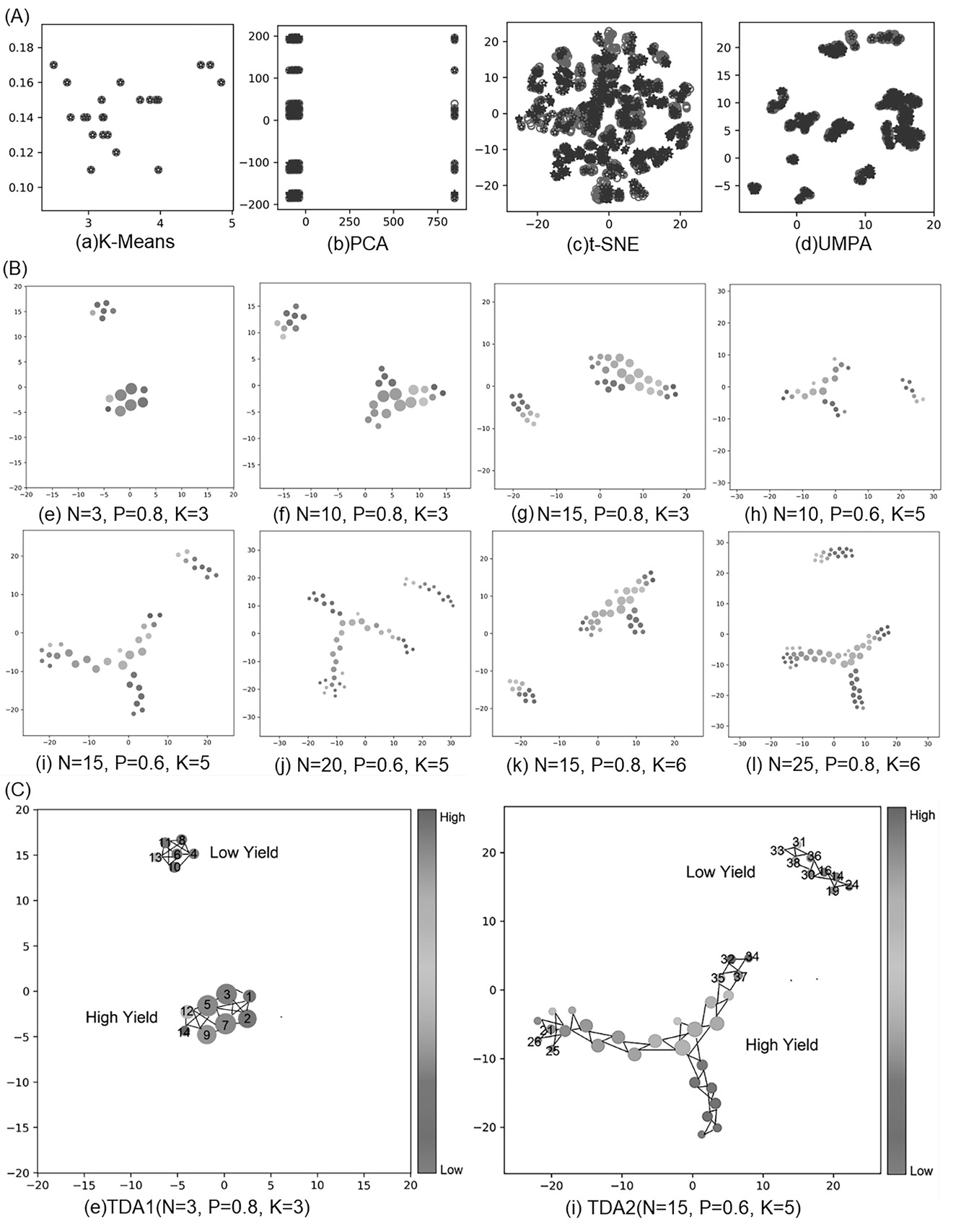
This work proposes OCS-TGBM, an intelligent organic chemical synthesis analysis model, which combines topological data analysis (TDA) and Light Gradient Boosting Machine (LightGBM). OCS-TGBM aims at deeply exploring the internal relationship between reaction conditions and yield, and obtaining high-yield reaction conditions and combinations. Additionally, in order to further enhance the generalization of OCS-TGBM, we design a stratified diversity sampling strategy for LightGBM in the training stage. Experiments show that OCS-TGBM is superior to other methods (e.g., XGBoost, SVR and MLPR) in analyzing and predicting the reaction performance of high-throughput organic chemical synthesis.
IB-AdCSCNet: Adaptive Convolutional Sparse Coding Network Driven by Information Bottleneck
He Zou, Meng'en Qin, Yu Song, Xiaohui Yang (corresponding author).
arXiv:2405.14192, 2024
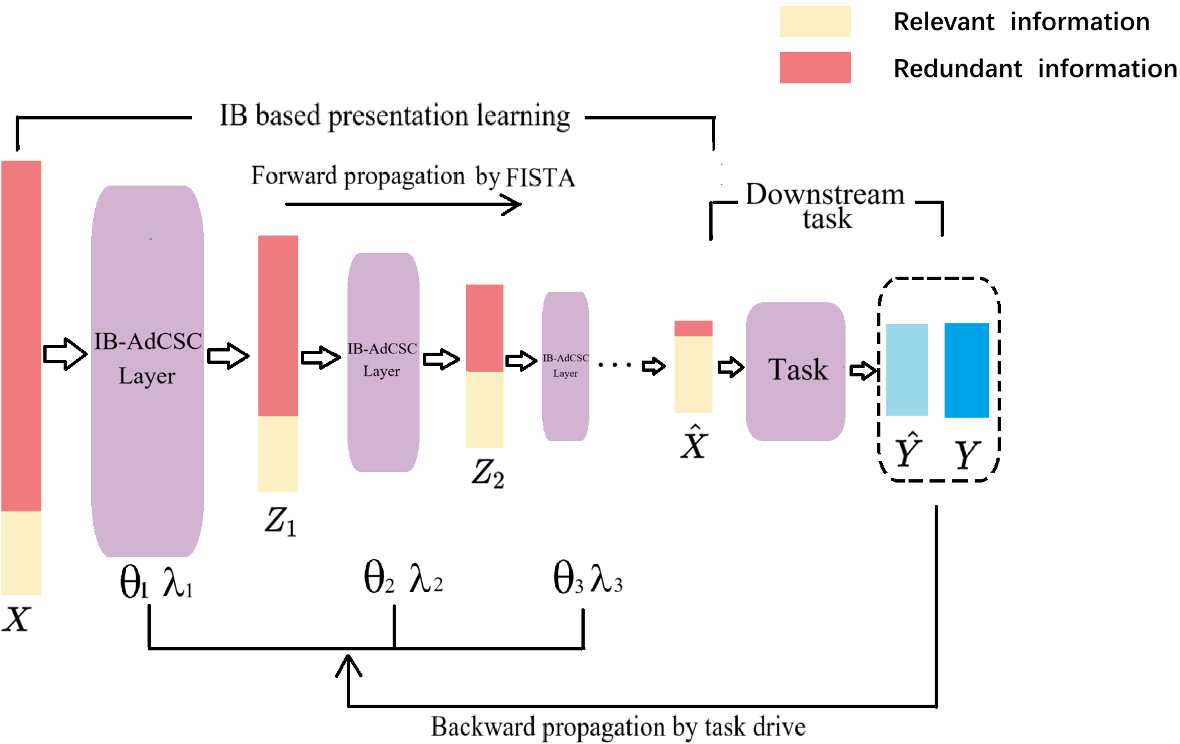
In neural network models, the perpetual challenge remains in retaining task-relevant information while effectively discarding redundant data during propagation. In this paper, we introduce IB-AdCSCNet, a deep learning model grounded in information bottleneck theory. IB-AdCSCNet seamlessly integrates the information bottleneck trade-off strategy into deep networks, and dynamically adjusts the trade-off hyperparameter λ by FISTA algorithm. By optimizing the compressive excitation loss induced by the information bottleneck principle, IB-AdCSCNet achieves an optimal balance between compression and fitting at a global level, approximating the globally optimal representation feature. This information bottleneck trade-off strategy driven by downstream tasks not only helps to learn effective features of the input data, but also improves the generalization of deep models. Experimental results on CIFAR-10 and CIFAR-100 demonstrate that IB-AdCSCNet not only matches the performance of deep residual convolutional networks but also outperforms them when handling corrupted data. Through the inference of the IB trade-off, the model’s robustness is notably enhanced.
OS-MSWGBM: Intelligent Analysis of Organic Synthesis Based on Multiscale Subtraction Weighted Network and LightGBM
Lanfeng Wang*, Yanhui Guo*, Zelin Zhang, Meng'en Qin, Zixin Li, Xiaoli Sun, Xiaohui Yang† (* equal contribution, † corresponding author).
In MATCH-COMMUNICATIONS IN MATHEMATICAL AND IN COMPUTER CHEMISTRY, 2025
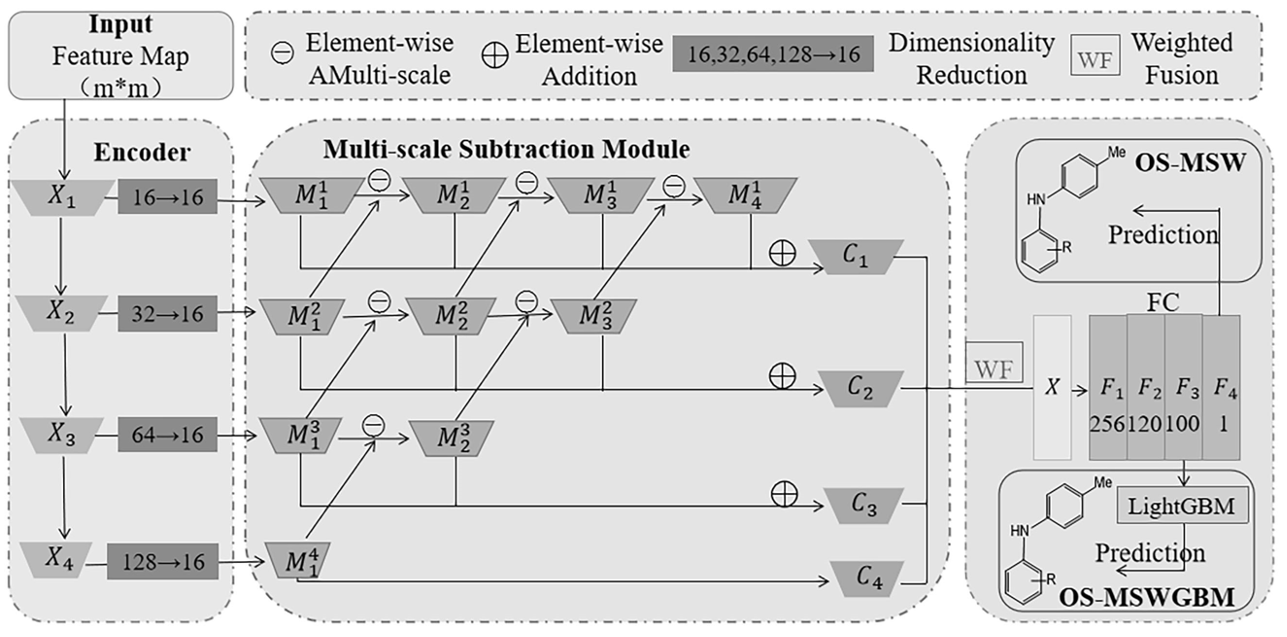
In this paper, we explore the three-dimensional and topological descriptors of cross-coupling reactions based on the molecular stick-and-ball model and persistent homology analysis, respectively. On this basis, a weighted light CNN with multi-scale subtraction (OS-MSW) is proposed to extract the deep abstract features of the input descriptors, and the extracted features are applied to LightGBM for yield prediction, thus constructing a highly efficient hybrid model, OS-MSWGBM.
StomaD²: An All-in-One System for Intelligent Stomatal Phenotype Analysis via Diffusion-Based Restoration Detection Network
Quanling Zhao*, Meng’en Qin*, Yanfeng Sun*, Jiahang Zhang, Lichao Peng, Han Qiao, Chenyang Du, Yuankai Chang, Yuan Miao†, Xiaohui Yang† (* equal contribution, † corresponding author).
Under review in New Phytologist, 2025
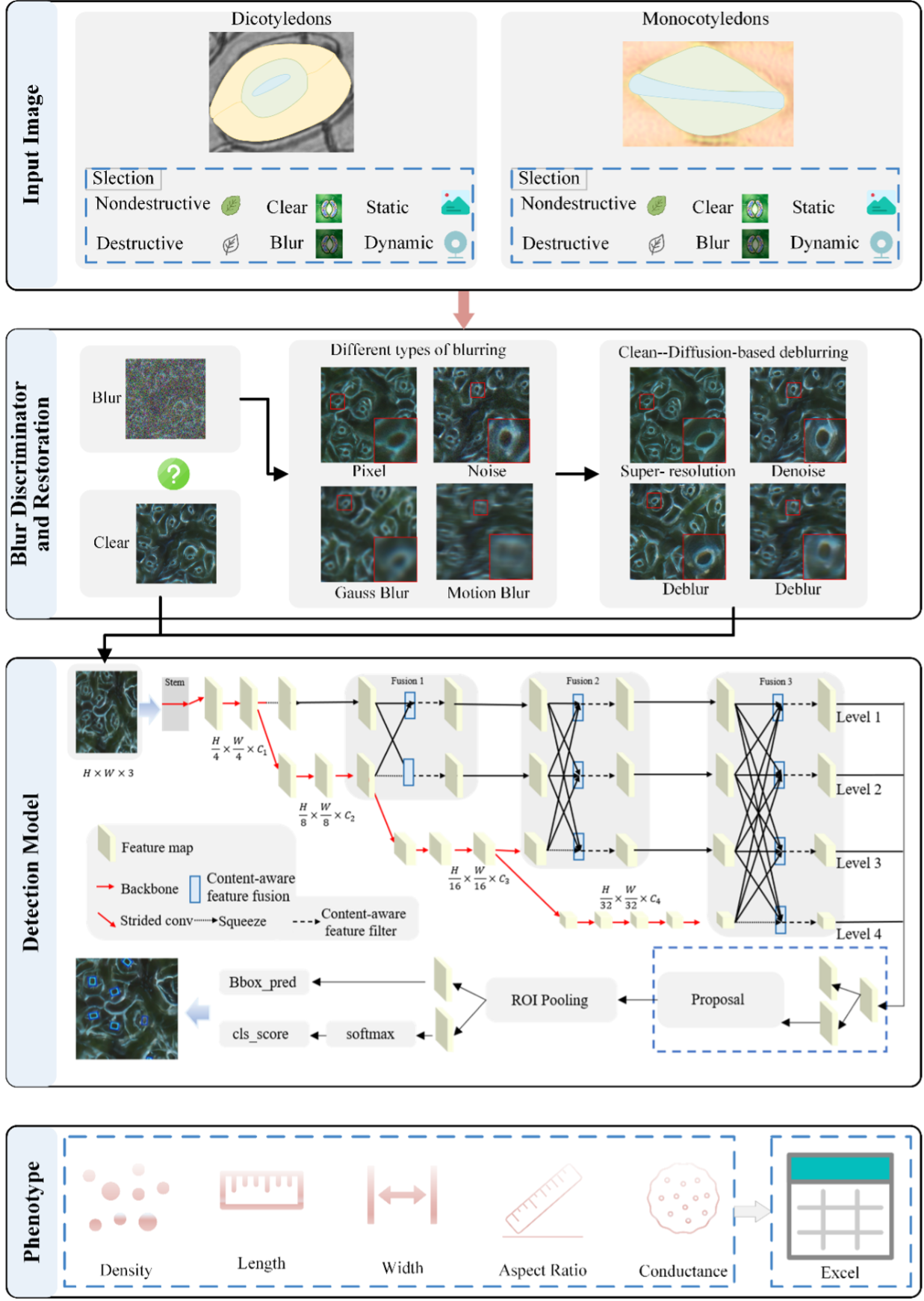
Stomata play a critical role in regulating key physiological processes in plants, particularly for monitoring dynamic changes in living tissues under environmental perturbations. However, accurate high-throughput phenotyping remains bottleneck, as traditional methods rely on destructive sampling and labor-intensive annotations, limiting large-scale and field applications. To solve these challenges, we specially design an oriented detection network for analyzing small, dense, and cluttered stomata in nondestructive images and complex environments. Additionally, a diffusion-based restoration model is introduced to recover blurred images and improve detection accuracy. Restoration and detection are integrated into \(\mathrm{StomaD^2}\), a user-friendly and easy-to-operate all-in-one system that supports nondestructive, in-field stomatal imaging and enables real-time dynamic analysis of stomatal phenotypes (density, conductance, etc.). \(\mathrm{StomaD^2}\) is compatible with both dicotyledonous and monocotyledonous species, destructive and nondestructive images of crop stomata. Experiments show that \(\mathrm{StomaD^2}\) achieves expert-level accuracy, and its generalizability has been validated across diverse plant types, highlighting its potential for large-scale phenotyping, plant physiology research, and precision agriculture.
A³-FPN: Asymptotic Content-Aware Pyramid Attention Network for Dense Visual Prediction
Meng’en Qin, Yu Song, Quanling Zhao, Yinchen Liu, Mingxuan Cui, Zihao Liu, Xiaohui Yang (corresponding author).
Under review in IEEE Transactions on Circuits and Systems for Video Technology (TCSVT), 2025
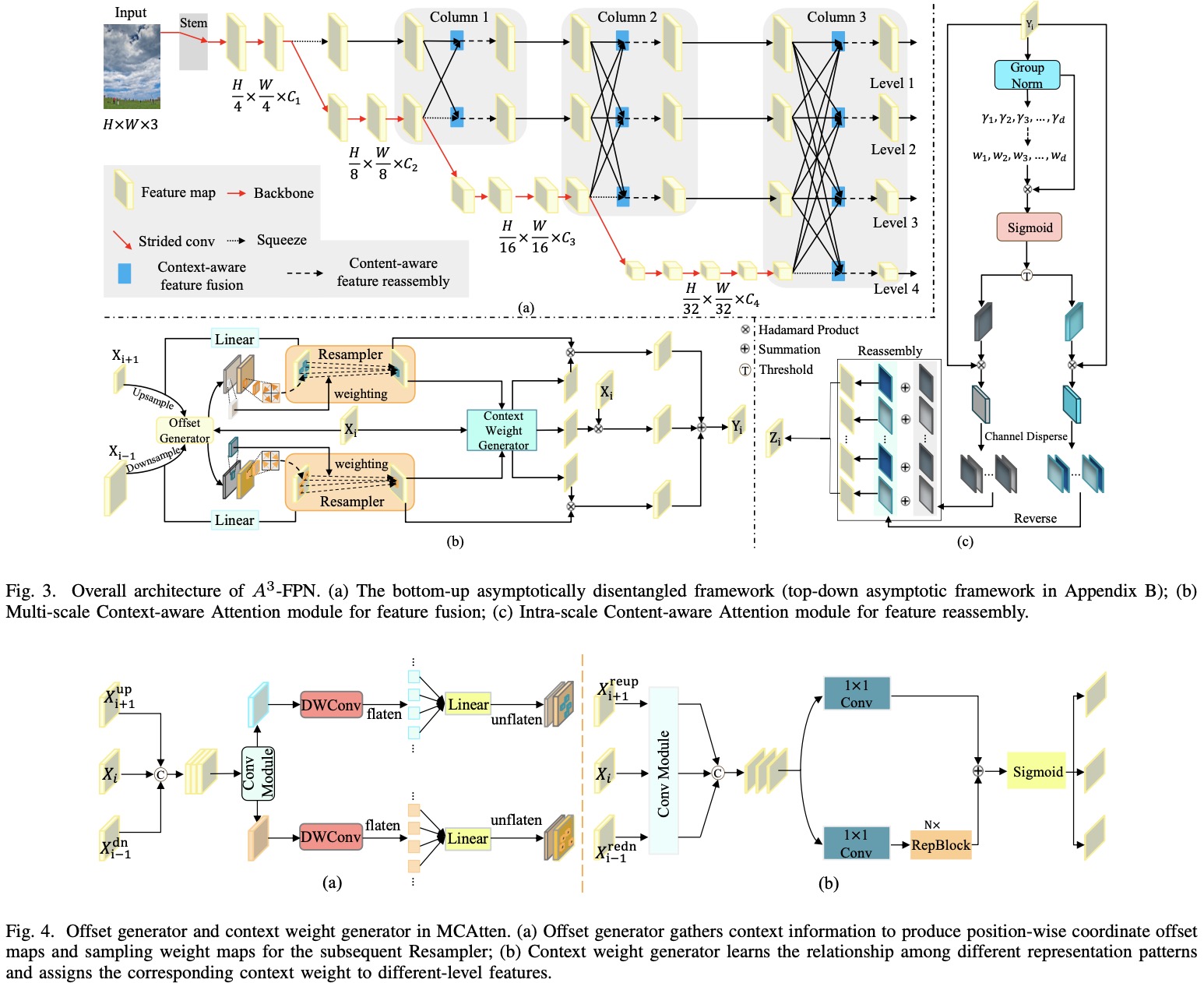
In this work, we identify three critical issues: information loss, context-agnostic sampling and pattern inconsistency in existing multi-scale feature fusion networks and operations. To tackle these issues, this paper proposes Asymptotic Content-Aware Pyramid Attention Network (\(\mathrm{A^3}\)-FPN). Specifically, \(\mathrm{A^3}\)-FPN employs a local-to-global convolutional attention network that gradually enables global feature interaction and disentangles each level from all hierarchical representations. In feature fusion, it collects supplementary content from the adjacent level to generate position-wise offsets and weights for context-aware resampling, and learns multi-scale context reweights to improve intra-category similarity. In feature reassembly, it further strengthens intra-scale discriminative feature learning and reassembles redundant features based on information density and spatial variation of feature maps. Extensive experiments on MS COCO and Cityscapes demonstrate that \(\mathrm{A^3}\)-FPN can easily yield remarkable performance gains on both CNNs and ViTs. Notably, when paired with OneFormer and Swin-L backbone, \(\mathrm{A^3}\)-FPN achieves 49.6 mask AP on MS COCO and 85.6 mIoU on Cityscapes. Furthermore, \(\mathrm{A^3}\)-FPN exhibits powerful capabilities in more precise detection and segmentation, particularly for small,cluttered, and dense objects.
